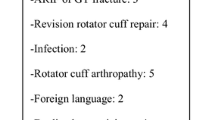Abstract
Aim
To evaluate the influence of the specific procedure performed and other variables on the intensity of acute postoperative pain following outpatient shoulder arthroscopy.
Methods
One hundred patients undergoing outpatient shoulder arthroscopy under single-shot interscalene block plus general anaesthesia were prospectively studied. Acetaminophen with ibuprofen was prescribed for postoperative pain control and tramadol HCl as rescue medication. Patients scored pain intensity at 2, 6, and 24 h postoperatively. The influence of the surgical procedure, age, gender, surgery duration, and irrigation volume used on the intensity of postoperative pain was studied.
Results
Five patients were excluded due to ineffective block or protocol deviation. Among the 95 remaining patients, 51 underwent rotator cuff tear repair, 25 shoulder stabilisation, and 19 subacromial decompression. While there were no differences at 2 and 6 h after surgery, pain intensity was significantly higher among those undergoing rotator cuff tear repair (5.2, 1–10) at 24 h compared to stabilisation (4.1, 1–8) or subacromial decompression (5, 1–8) (p < 0.0001). No association was found between pain intensity and other variables.
Conclusion
A higher degree of acute postoperative pain should be expected in patients undergoing arthroscopic rotator cuff tear repair compared to other arthroscopic shoulder procedures, and additional pain treatment is recommended.

Similar content being viewed by others
References
Bishop JY, Sprague M, Gelber J et al (2006) Interscalene regional anesthesia for arthroscopic shoulder surgery: a safe and effective technique. J Shoulder Elb Surg 15:567–570. https://doi.org/10.1016/j.jse.2006.01.009
Iyengar JJ, Samagh SP, Schairer W, Singh G, Valone FH, Feeley BT (2014) Current trends in rotator cuff repair: surgical technique, setting and cost. Arthroscopy 30:284–288. https://doi.org/10.1016/j.arthro.2013.11.018
Fontana C, Di Donato A, Di Giacomo G et al (2009) Postoperative analgesia for arthroscopic shoulder surgery: a prospective randomized controlled study of intraarticular, subacromial injection, interscalenic brachial plexus block and intraarticular plus subacromial injection efficacy. Eur J Anaesthesiol 26:689–693. https://doi.org/10.1111/j.1399-6576.2006.01204
Trompeter A, Camilleri G, Narang K, Hauf W, Venn R (2010) Analgesia requirements after interscalene block for shoulder arthroscopy: the 5 days following surgery. Arch Orthop Trauma Surg 130:417–421. https://doi.org/10.1007/s00402-009-0959-9
Banerjee SS, Pulido P, Adelson WS, Fronek J, Honecke HR (2008) The efficacy of continuous bupivacaine infiltration following arthroscopic rotator cuff repair. Arthroscopy 24:397–402. https://doi.org/10.1016/j.arthro.2007.10.002
Bryan NA, Swenson JD, Greis PE, Burks RT (2007) Indwelling interscalene catheter use in an outpatient setting for shoulder surgery; technique, efficacy, and complications. J Shoulder Elb Surg 16:388–395. https://doi.org/10.1016/j.jse.2006.10.012
Busfield BT, Lee GH, Carrillo M, Ortega R, Kharrazi FD (2008) Subacromial pain pump use with arthroscopic shoulder surgery: a short-term prospective study of complications in 583 patients. J Shoulder Elb Surg 17:860–862. https://doi.org/10.1016/j.jse.2008.03.011
Coghlan JA, Forbes A, McKenzie D, Bell SN, Buchbinder R (2009) Efficacy of subacromial ropivacaine infusion for rotator cuff surgery. A randomized trial. J Bone Jt Surg Am 91:1558–1567. https://doi.org/10.2106/JBJS.H.00948
Stiglitz Y, Gosselin O, Sedaghatian J, Sirveaux F, Molé D (2011) Pain after shoulder arthroscopy: a prospective study on 231 cases. Orthop Traumatol Surg Res 97:260–266. https://doi.org/10.1016/j.otsr.2011.02.003
Winkler T, Suda AJ, Dumitrescu RV et al (2009) Interscalene versus subacromial continuous infusión of ropivacaine after arthroscopic acromioplasty: a randomized control trial. J Shoulder Elb Surg 18:566–572. https://doi.org/10.1016/j.jse.2008.11.005
Lemo P, Pinto A, Morais G et al (2009) Patient satisfaction following day surgery. J Clin Anesth 21:200–205. https://doi.org/10.1016/j.jclinane.2008.08.016
Faryniarz D, Morelli C, Coleman S et al (2006) Interscalene block anesthesia at an ambulatory surgery center performing predominantly regional anesthesia: a prospective study of one hundred thirty-three patients undergoing shoulder surgery. J Shoulder Elb Surg 15:686–690. https://doi.org/10.1016/j.jse.2006.02.001
Elkassabany NM, Wang A, Ochroch J et al (2018) Improved quality of recovery from ambulatory shoulder surgery after implementation of a multimodal perioperative pain management protocol. Pain Med. https://doi.org/10.1093/pm/pny152 (Epub ahead of print)
Chao D, Young S, Cawley P (2006) Postoperative pain management for arthroscopic shoulder surgery: interscalenic block versus patient-controlled infusion of 0.25% bupivacaine. Am J Orthop 35:231–234
Webb D, Guttmann D, Cawley P, Lubowitz JH (2007) Continuos infusion of a local anesthetic versus interscalene block for postoperative pain control after arthroscopic shoulder surgery. Arthroscopy 23: 1006–1011. https://doi.org/10.1016/j.arthro.2007.04.008
Passannante AN (1996) Spinal anesthesia and permanent neurologic deficit after interscalene block. Anesth Analg 82:873–874
Busfield BT, Romero DM (2009) Pain pump use after shoulder arthroscopy as a cause of glenohumeral chondrolysis. Arthroscopy 25:647–652. https://doi.org/10.1016/j.arthro.2009.01.019
Rapley JH, Beavis RC, Barber FA (2009) Glenohumeral chondrolysis after shoulder arthroscopy associated with continuous bupivacaine infusion. Arthroscopy 25:1367–1373. https://doi.org/10.1016/j.arthro.2009.08.024
Mayfield JB, Carter C, Wang C, Warner JJ (2001) Arthroscopic shoulder reconstruction: fast-track recovery and outpatient treatment. Clin Orthop Relat Res 390:10–16
Wilson AC, Nicholson E, Burton L, Wild C (2004) Analgesia for day-case shoulder surgery. Br J Anaesth 92:414–415. https://doi.org/10.1093/bja/aeh071
Davis A, Chinn DJ, Sharma S (2013) Prediction of post-operative pain following subacromial decompression surgery: an observational study. F1000Research 2:31. https://doi.org/10.12688/f1000research.2-31.v1
Twersky RS, Sapozhnikova S, Toure B (2008); Risk factors associated with fast-track ineligibility after monitored anesthesia care in ambulatory surgery patients. Anesth Analg 106:1421–1426. https://doi.org/10.1213/ane.0b013e31816a6600
Weber SC, Jain R, Parise C (2007) Pain scores in the management of postoperative pain in shoulder surgery. Arthroscopy 23:65–72. https://doi.org/10.1016/j.arthro.2006.11.002
Koorevaar RCT, van’t Riet E, Ipskamp M, Bulstra SK (2017) Incidence and prognostic factors for postoperative frozen shoulder after shoulder surgery: a prospective cohort study. Arch Orthop Trauma Surg 137:293–301. https://doi.org/10.1007/s00402-016-2589-3
Bayle X, Pham TT, Faruch M, Gobet A, Mansat P, Bonnevialle N (2017) No difference in outcome for open versus arthroscopic rotator cuff repair: a prospective comparative trial. Arch Orthop Trauma Surg 137:1707–1712. https://doi.org/10.1007/s00402-017-2796-6
Funding
There is no funding source.
Author information
Authors and Affiliations
Corresponding author
Ethics declarations
Conflict of interest
The authors declare that they have no conflict of interest.
Ethical approval
The Institutional Review Board of Hospital Universitario Fundación Jiménez Díaz (Universidad Autónoma de Madrid) approved the study (no. EO 05/2009).
Informed consent
Informed consent was obtained from all individual participants included in the study.
Rights and permissions
About this article
Cite this article
Calvo, E., Torres, M.D., Morcillo, D. et al. Rotator cuff repair is more painful than other arthroscopic shoulder procedures. Arch Orthop Trauma Surg 139, 669–674 (2019). https://doi.org/10.1007/s00402-018-3100-0
Received:
Published:
Issue Date:
DOI: https://doi.org/10.1007/s00402-018-3100-0



